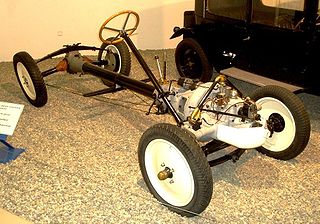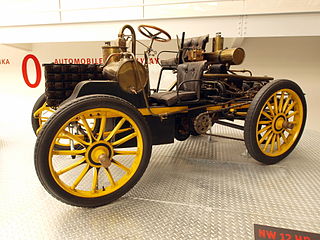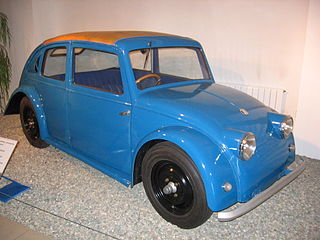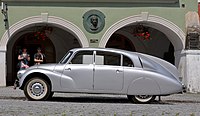
Škoda Auto a.s., often shortened to Škoda, is a Czech automobile manufacturer established in 1925 as the successor to Laurin & Klement and headquartered in Mladá Boleslav, Czech Republic. Škoda Works became state owned in 1948. After 1991, it was gradually privatized to the German Volkswagen Group, becoming a partial subsidiary in 1994 and a wholly owned subsidiary in 2000.

Tatra is a Czech vehicle manufacturer from Kopřivnice. It is owned by the TATRA TRUCKS a.s. company, and it is the third oldest company in the world producing motor vehicles with an unbroken history. The company was founded in 1850 as Ignatz Schustala & Cie. In 1890 the company became a joint-stock company and was renamed the Nesselsdorfer Wagenbau-Fabriksgesellschaft. In 1897, the Nesselsdorfer Wagenbau-Fabriksgesellschaft produced the Präsident, which was the first factory-produced automobile with a petrol engine to be made in Central and Eastern Europe. In 1918, the company was renamed Kopřivnická vozovka a.s., and in 1919 it changed from the Nesselsdorfer marque to the Tatra badge, named after the nearby Tatra Mountains on the Czechoslovak-Polish border.

Hans Ledwinka was an Austrian automobile designer.

The Czechoslovakian Tatra 77 (T77) is one of the first serial-produced, truly aerodynamically-designed automobiles. It was developed by Hans Ledwinka and Paul Jaray, the Zeppelin aerodynamic engineer. Launched in 1934, the Tatra 77 is a coach-built automobile, constructed on a platform chassis with a pressed box-section steel backbone rather than Tatra's trademark tubular chassis, and is powered by a 60 horsepower (45 kW) rear-mounted 2.97-litre air-cooled V8 engine, in later series increased to a 75 horsepower (56 kW) 3.4-litre engine. It possessed advanced engineering features, such as overhead valves, hemispherical combustion chambers, a dry sump, fully independent suspension, rear swing axles and extensive use of lightweight magnesium alloy for the engine, transmission, suspension and body. The average drag coefficient of a 1:5 model of Tatra 77 was recorded as 0.2455. The later model T77a has a top speed of over 150 km/h (93 mph) due to its advanced aerodynamic design which delivers an exceptionally low drag coefficient of 0.212, although some sources claim that this is the coefficient of a 1:5 scale model, not of the car itself. Recent article confirmed the Tatra 77/77a drag coefficient for real full-size car as 0.36.

Backbone tube chassis is a type of automobile construction chassis that is similar to the body-on-frame design. Instead of a two-dimensional ladder-type structure, it consists of a strong tubular backbone that connects the front and rear suspension attachment areas. A body is then placed on this structure. It was first used in the English Rover 8hp of 1904 and then the French Simplicia automobile in 1909.

The Tatra 87 (T87) is a car built by Czechoslovak manufacturer Tatra. It was powered by a rear-mounted 2.9-litre air-cooled 90-degree overhead cam V8 engine that produced 85 horsepower and could drive the car at nearly 100 mph (160 km/h). It is ranked among the fastest production cars of its time. Competing cars in this class, however, used engines with almost twice the displacement, and with fuel consumption of 20 liters per 100 km. Thanks to its aerodynamic shape, the Tatra 87 had a consumption of just 12.5 litres per 100 km. After the war between 1950 and 1953, T87s were fitted with more-modern 2.5-litre V8 T603 engines.

The Tatra 97 (T97) is a Czechoslovak mid-size car built by Tatra in Kopřivnice, Moravia from 1936 to 1939.

The Tatra 603 is a large rear-engined luxury car which was produced by the Czechoslovak company Tatra from 1956 to 1975. It was a continuation of the series of Tatra streamlined sedans which began with the Tatra 77. In Socialist Czechoslovakia, only high-ranking party officials and heads of factories were driven in 603s; the car was also exported to a number of other countries.
Julius Mackerle was a Czech inventor and automobile engineer.

The Tatra 12 is an automobile produced by Czech manufacturer Tatra between 1926 and 1933. It was replaced by the Tatra 57 in 1932.

Erich Übelacker was a German automobile engineer.
Ivan Margolius is an author, architect and propagator of Czech culture and technology.

The Double Racer is a race car manufactured by the Nesselsdorfer Wagenbau-Fabriksgesellschaft (NW), now Tatra, in 1900. It is sometimes also called First Racing, 12 HP, or Race Car. It was commissioned by Baron Theodor von Liebieg. Hans Ledwinka, the man behind the famous rear-engined Tatras, and at the time only 20 years old, helped in the production of the car. The car was designed and built in a five week period in April and May 1900. The Rennzweier was the first car designed specifically for racing to be built in Central Europe.

The Tatra V570 was a prototype 1931-33 car developed by a team led by Hans Ledwinka, Erich Ledwinka and Erich Übelacker. The aim of the construction team was to develop a cheap people's car with an aerodynamic body. The first T57-V570 prototype with rear air-cooled two-cylinder engine placed in the former rear luggage compartment of conventional T57 two-seater droped head coupe was completed late in 1931. However, the company's management decided that the revolutionary ideas introduced in the prototype should be introduced in large luxurious cars, and therefore the team abandoned the project of small cars in favour of the Tatra T77, the world's first serially produced aerodynamic car. The project of a small car was later continued and led to introduction of the Tatra T97. The second, now streamlined V570 four-seater was built in 1933, two years before the first Volkswagen, which bears a strong resemblance to the Tatra – it was misappropriated in the opinion of Tatra, by Adolf Hitler and Dr. Ferdinand Porsche in circumstances about which the German company remains intensely sensitive.

The Präsident was an automobile manufactured by the Nesselsdorfer Wagenbau-Fabriks-Gesellschaft, now Tatra, in 1897. It was the first practical, factory-produced petrol engine automobile built in Central and Eastern Europe. It was constructed by Leopold Sviták and Hans Ledwinka. The automobile was more of a carriage without horses than a car in modern sense. The car is steered via handlebars. The wooden bodywork is placed on an iron frame. It has four seats and a convertible top that would cover only the rear seats. Both axles have suspension of semi-elliptical leaf springs. The wheels were similar to the ones of a horse carriage, but had rubber tyres. The car had a two cylinder spark ignition Benz engine placed by the rear axle.

The Škoda VOS is a full-size luxury car produced by the Czechoslovak automaker AZNP at their plant in Mladá Boleslav between 1949 and 1952. For a few years it was the preferred car for senior political and military personnel in Czechoslovakia. It was never sold to the general public.
Joseph Ledwinka was an automobile engineer.

The Škoda Rapid is a mid-size car that was made in Czechoslovakia by Škoda from 1935 to 1947. Škoda had first applied the "Rapid" name to a version of its 1,195 cc Popular Type 920 made in 1934–35. From 1935, however, it transferred the name to a new, larger model.

The Škoda Popular is a small family car that was made in Czechoslovakia by Škoda from 1933 to 1946. It was the company's most affordable car at the time.

The original Škoda Superb is a full size luxury car that was made by the Czechoslovak car manufacturer ASAP, later AZNP from 1934 to 1949. It was the company's first car with a V8 engine and all-wheel drive.






















